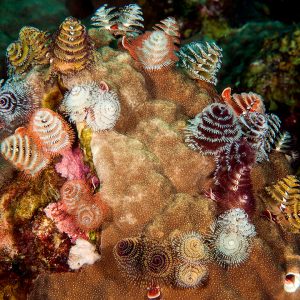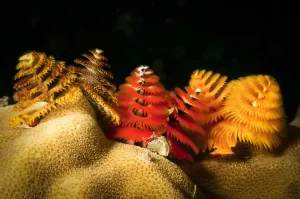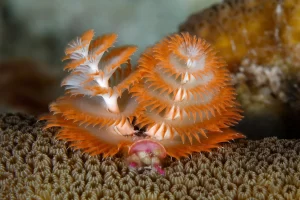You won’t find Spirobranchus giganteus, also known as the Christmas tree worm, eating your spruce this year. The common name of these worms comes from their appearance, not from their habitat or diet.
Each worm has two brightly colored crowns that protrude from its tubular body. These crowns, similar to Christmas trees, consist of parents or hair-like appendages radiating from the central spine of the worm. These appendages are used for breathing and catching lunch, which usually consists of microscopic plants or phytoplankton floating in the water.
These worms are sedentary, which means that once they find a place they like, they don’t move much. In fact, while the colorful crowns of these worms are visible, most of their bodies are anchored in burrows that they have made in living corals. Frightened, the Christmas worms quickly go into their burrows, hiding from potential predators.

Christmas tree worms come in a variety of bright colors. They are not very large, on average about 3.8 centimeters in length. However, because of their distinctive shape, beauty and color, these worms are easy to spot. They are among the most widely recognized polychaete or marine burrowing segmented worms.
Weight and length
Christmas tree worms average about 1.5 inches in length, and their radioles can have a diameter of up to 1.5 inches. Because of their tiny size, they weigh only a few ounces. Many of them do not grow above one inch.
Physical characteristics and color
These worms have two crowns protruding from their tubular bodies. The crowns resemble Christmas trees, consisting of radicals, which are appendages similar to hair coming from the spine of a worm. Their crowns come in a variety of bright colors, from white, blue, red, orange and yellow. Radiols breathe and catch food with the help of cilia, which are hair-like bristles.
Since worms mostly lead a sedentary lifestyle, they lack specialized appendages necessary for swimming. Unlike the closely related fanworm Sabellidae, Christmas tree worms have a modified radiole called an operculum that protects its opening when they are removed into their tube.
The body of the worm is formed after the larvae settle on the coral. The coral then grows around the worm, forming a tube. The worm’s parapodia (legs) and bristles remain in the tube, and they are about twice as long as the part of the worm visible above the coral.

Life expectancy and reproduction
Christmas tree worms have a lifespan of about 40 years in an uncontaminated habitat. Most often they live from 10 to 20 years due to climate change and predation.
Female worms send eggs, and males send sperm into the water for reproduction. Gametes originate from their abdominal segments, and the eggs are fertilized separately from the female worm. This reproductive process forces them to broadcast spawners.
After fertilization, the eggs develop into larvae within 24 hours, and then drift along with zooplankton for 9-12 days while they develop into larvae. Larvae that settle on some ship, where they form a mucous tube that becomes calcareous, and these creatures become Christmas tree worms.
Habitat
Where Does the Christmas Tree Worm Live?
The Christmas tree worm lives in tropical oceans between the Caribbean and Indo-Pacific. They prefer shallow waters under 100 feet in depth.
After their larval lifespan, Christmas tree worms choose a coral habitat. They prefer specific species, including stony and brain corals. The colony density varies between a handful to over 100 worms per coral head, depending on the parent worm’s size and the coral’s health.
Once the larva has selected a coral, it constructs a calcium carbonate tube that remains its permanent home throughout its lifespan. Their tubes can develop between eight and ten inches in length, and the worms produce them by excreting calcium carbonate obtained from ingesting sand particles.
Since the tube is significantly longer than the worm, the worm can retract fully within it if it feels threatened. Once withdrawn, the worm can use its spiny operculum to plug the tube hole and defend itself from predators.

Food & Diet
What Does the Christmas Tree Worm Eat?
The Christmas tree worm eats by trapping ciliates, zooplankton, organic detritus, phytoplankton, and other food particles with their radioles. The heavily-ciliated radioles pass the food into the worm’s mouth.
Their feeding process also goes by filter-feeding since they use their radioles to filter the best microorganisms for them to eat.
